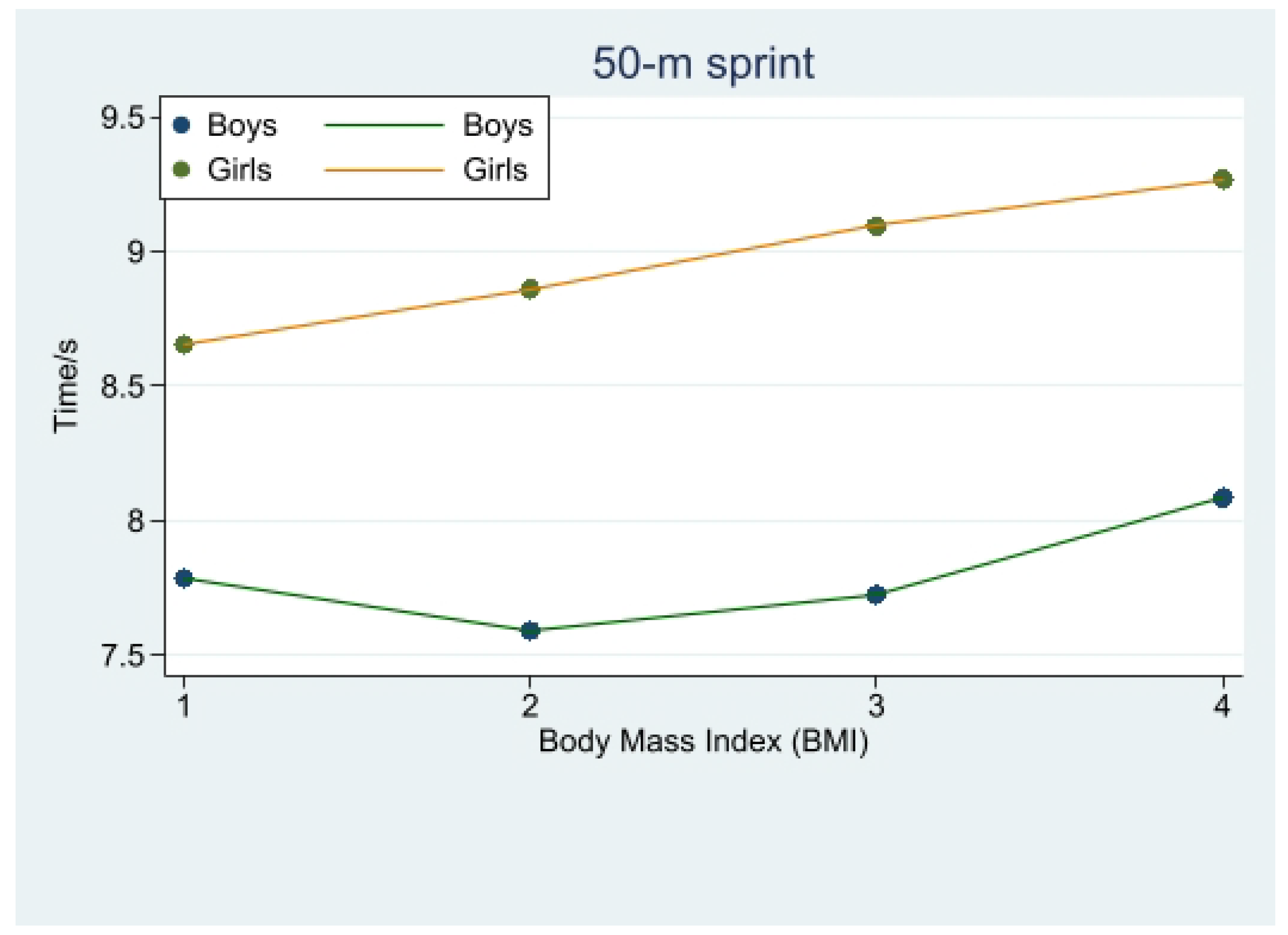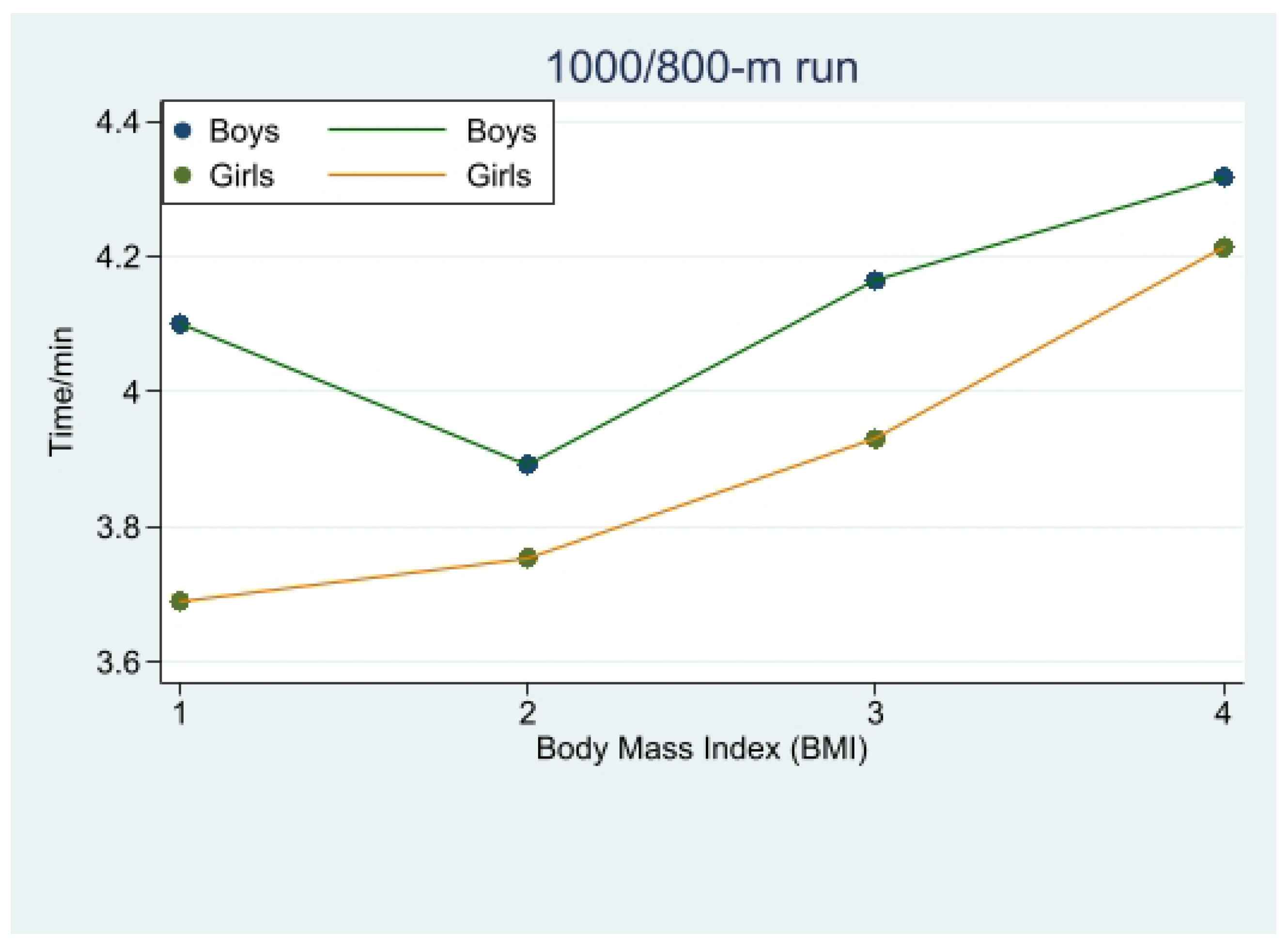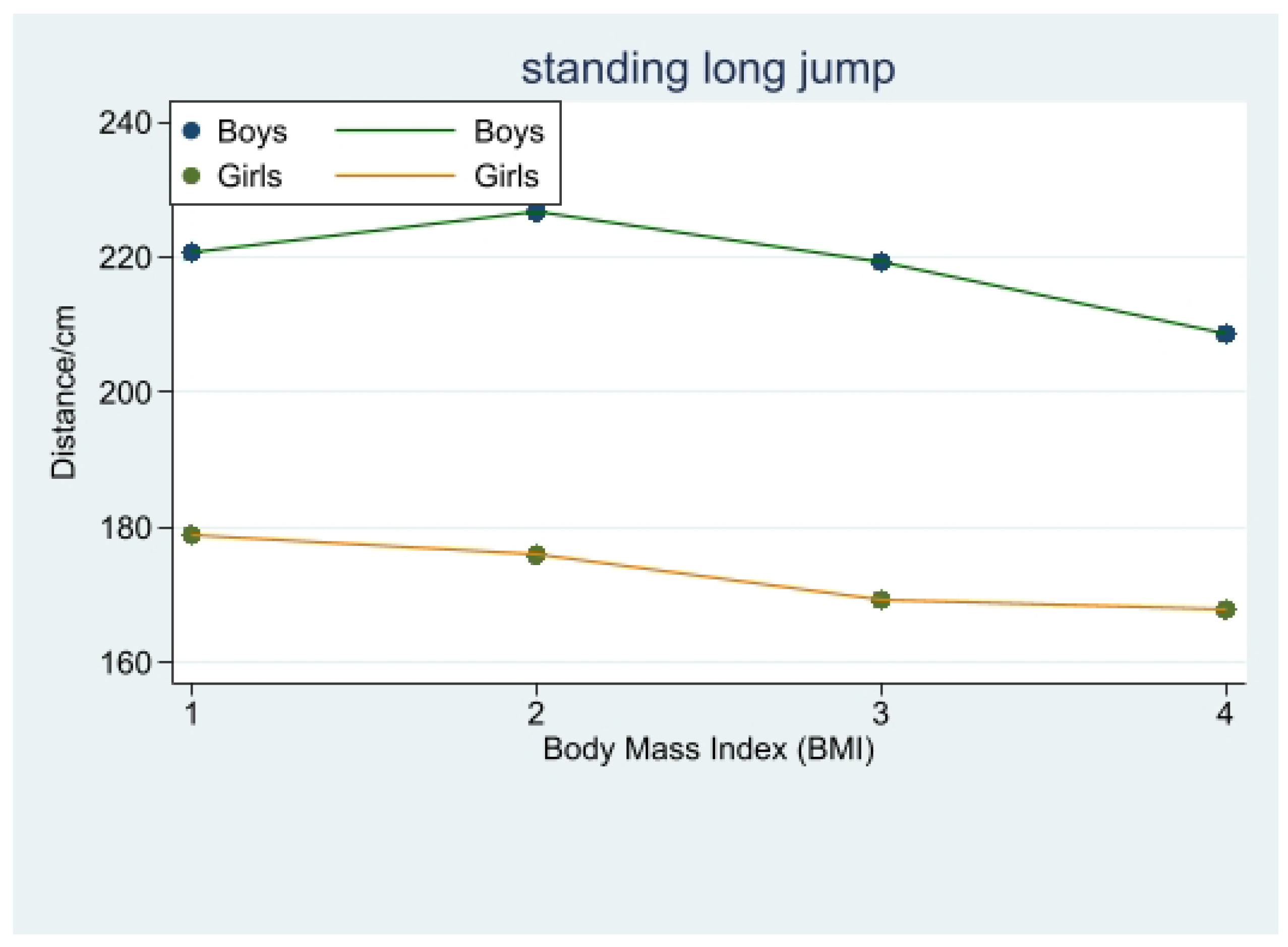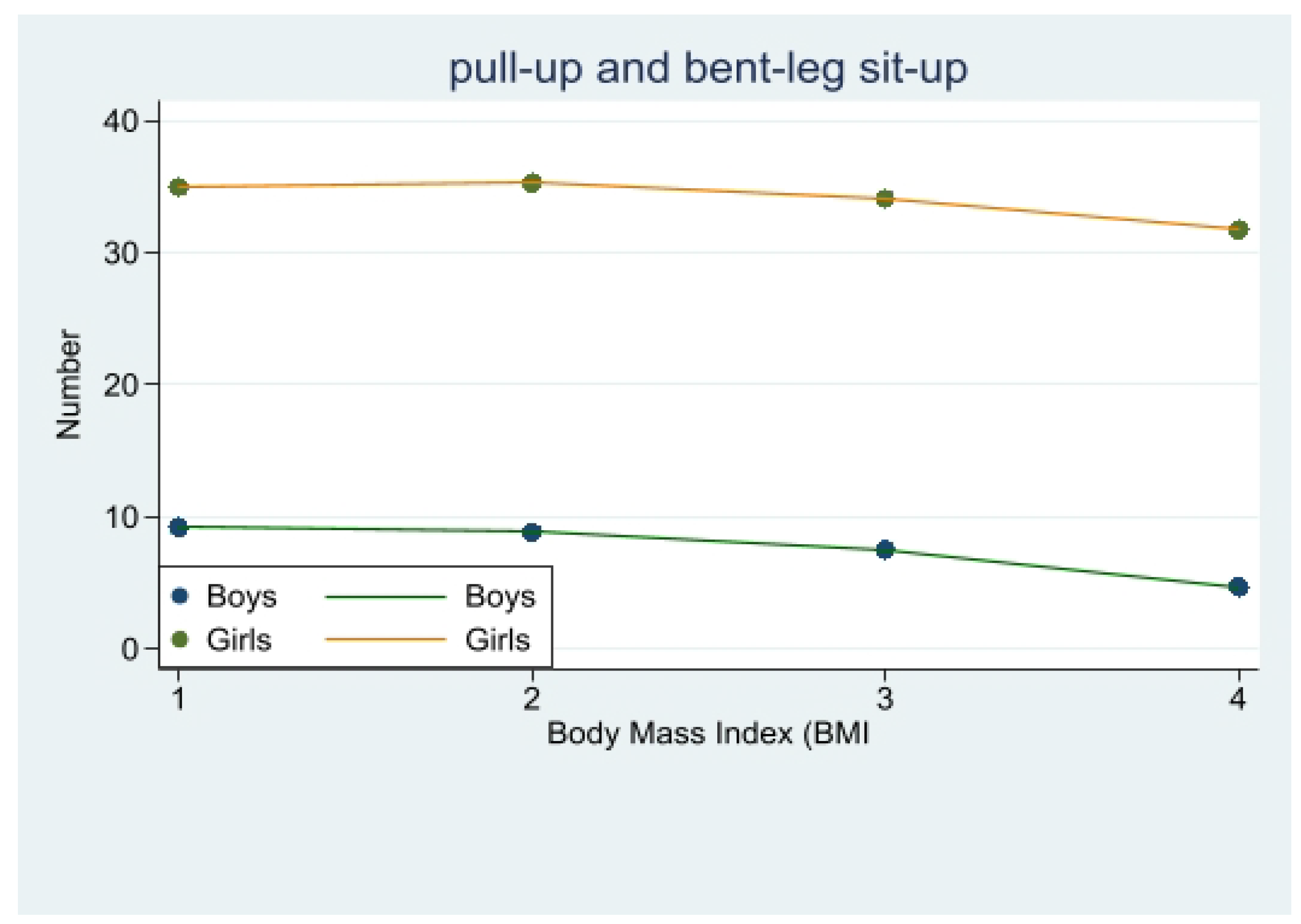Body Mass Index and Physical Fitness among Chinese Adolescents Aged 15–18: A Cross-Sectional Study of Gender Differences
Abstract
1. Introduction
2. Materials and Methods
2.1. Fitness Test
2.1.1. 50 m Sprint
2.1.2. 1000 m/800 m Run
2.1.3. Standing Long Jump
2.1.4. Sit and Reach
2.1.5. Pull-Ups
2.2. Data
2.3. Research Methods
2.4. Statistical Analyses
3. Results
3.1. Gender Differences in the Relationship between BMI and 50 m Sprint Performance
3.2. Gender Differences in the Relationship between BMI and 1000/800 m Run Performance
3.3. Gender Differences in the Relationship between BMI and Standing Long Jump Performance
3.4. Gender Differences in the Relationship between BMI and Sit and Reach Scores
3.5. Gender Differences in the Relationship between BMI and Pull-Up and Bent-Leg Sit-Up Performance
4. Discussion
4.1. Exploring the Relationship between Body Mass Index and 50 m Sprint Performance in Different Genders
4.2. Exploring the Relationship between Body Mass Index and 1000/800 m Run Performance in Different Genders
4.3. Exploring the Relationship between Body Mass Index and Standing Long Jump Performance in Different Genders
4.4. Exploring the Relationship between Body Mass Index and Sit and Reach Performance in Different Genders
4.5. Exploring the Relationship between Body Mass Index and Pull-Up and Bent-Leg Sit-Up Performance in Different Genders
4.6. Limitations
5. Conclusions
- Non-linear relationship: The study identified a significant non-linear relationship between BMI levels and physical fitness test scores. This suggests that there is an optimal BMI range for achieving higher physical fitness performance, while deviating from this range, either towards underweight or overweight/obesity, can negatively impact physical fitness;
- Gender differences: Gender differences were observed in physical fitness and overall health outcomes. Normal-weight boys achieved the highest physical fitness test scores, and demonstrated better overall health levels compared to boys in other weight categories. On the other hand, underweight and normal-weight girls outperformed overweight and obese girls in physical fitness tests, with underweight girls scoring slightly higher than those with normal weight;
- Cultural influence: The study suggests that the cultural associations between thinness and beauty among girls in China may contribute to the observed gender differences. The pressure to maintain a slim figure among girls might lead to a higher prevalence of underweight individuals, which could explain their better physical fitness performance.
6. Recommendations
- BMI education and awareness: Public health interventions should prioritize raising awareness about the importance of maintaining a healthy BMI for optimal physical fitness. This could involve educating adolescents, parents, and educators about the potential risks associated with both underweight and overweight/obesity, emphasizing the need for a balanced approach to weight management;
- Gender-specific approaches: Physical education programs should consider implementing gender-specific strategies to address the unique challenges faced by boys and girls. For boys, promoting healthy weight maintenance and providing opportunities for physical activity could further enhance their physical fitness. For girls, interventions should focus on fostering positive body image and self-esteem, moving away from the cultural pressure for extreme thinness;
- Inclusive fitness programs: It is essential to design physical education programs that are inclusive and accessible to all students, regardless of their BMI category. Encouraging participation in a variety of physical activities, promoting teamwork, and focusing on individual progress rather than weight-related outcomes, can create a supportive environment for all adolescents;
- Policy support: Policymakers should consider integrating BMI monitoring and fitness assessments into school health programs. This would help identify students who may require additional support and enable targeted interventions.
Author Contributions
Funding
Informed Consent Statement
Data Availability Statement
Acknowledgments
Conflicts of Interest
References
- World Health Organization. Obesity and Overweight. Available online: https://www.who.int/news-room/fact-sheets/detail/obesity-and-overweight (accessed on 8 March 2023).
- Bull, F.C.; Al-Ansari, S.S.; Biddle, S.; Borodulin, K.; Buman, M.P.; Cardon, G.; Carty, C.; Chaput, J.-P.; Chastin, S.; Chou, R.; et al. World Health Organization 2020 guidelines on physical activity and sedentary behaviour. Br. J. Sport. Med. 2020, 54, 1451–1462. [Google Scholar] [CrossRef] [PubMed]
- Duan, J.; Hu, H.; Wang, G.; Arao, T. Study on Current Levels of Physical Activity and Sedentary Behavior among Middle School Students in Beijing, China. PLoS ONE 2015, 10, e0133544. [Google Scholar] [CrossRef]
- Cui, Z.; Hardy, L.L.; Dibley, M.J.; Bauman, A. Temporal trends and recent correlates in sedentary behaviours in Chinese children. Int. J. Behav. Nutr. Phys. Act. 2011, 8, 93. [Google Scholar] [CrossRef]
- Zhai, L.; Dong, Y.; Bai, Y.; Wei, W.; Jia, L. Trends in obesity, overweight, and malnutrition among children and adolescents in Shenyang, China in 2010 and 2014: A multiple cross-sectional study. BMC Public Health 2017, 17, 151. [Google Scholar] [CrossRef]
- Song, Y.; Lei, Y.T.; Hu, P.J.; Zhang, B.; Ma, J. Situation analysis of physical fitness among Chinese Han students in 2014. Beijing Da Xue Xue Bao Yi Xue Ban 2018, 50, 436–442. [Google Scholar] [PubMed]
- Dong, Y.H.; Wang, Z.H.; Yang, Z.G.; Wang, X.J.; Chen, Y.J.; Zou, Z.Y.; Ma, J. Epidemic status and secular trends of malnutrition among children and adolescents aged 7–18 years from 2005 to 2014 in China. Beijing Da Xue Xue Bao Yi Xue Ban 2017, 49, 424–432. [Google Scholar] [PubMed]
- Ministry of Education of the People’s Republic of China. Notice of theMinistry of Education on the National Student Physical Fitness Standard (Revised 2014). Available online: http://www.moe.gov.cn/s78/A17/twys_left/moe_938/moe_792/s3273/201407/t20140708_171692.html (accessed on 8 January 2023).
- Shandong University. Adolescent Health subject Database. National Population Health Science Data Center Data Warehousing PHDA. 2021. Available online: https://www.ncmi.cn//phda/dataDetails.do?id=CSTR:17970.11.A0031.202107.209.V1.0 (accessed on 28 May 2023).
- Zhang, S.F.; Luo, W.; Dong, X.S.; Chen, W.X.; Yi, X.R.; Zhou, W.; Zhang, Y.; Zhao, Y.Z. A Dataset on the Status Quo of Health and Health-Related Behaviors of Chinese Youth: A Longitudinal Large-Scale Survey in the Secondary School Students of Shandong Province. Chin. Med. Sci. J. 2022, 37, 60–66. [Google Scholar] [CrossRef]
- Zhang, Y.; Su, F.; Song, Y.; Lu, J. Associations between Physical Fitness Index and Body Mass Index in Tibetan Children and Adolescents in Different High-Altitude Areas: Based on a Study in Tibet, China. Int. J. Environ. Res. Public Health 2022, 19, 10155. [Google Scholar] [CrossRef]
- Aires, L.; Silva, P.; Santos, R.; Santos, P.; Ribeiro, J.C.; Mota, J. Association of physical fitness and body mass index in youth. Minerva Pediatr. 2008, 60, 397–405. [Google Scholar]
- Yi, X.; Fu, Y.; Burns, R.D.; Bai, Y.; Zhang, P. Body mass index and physical fitness among Chinese adolescents from Shandong Province: A cross-sectional study. BMC Public Health 2019, 19, 81. [Google Scholar] [CrossRef]
- Okorodudu, D.O.; Jumean, M.F.; Montori, V.M.; Romero-Corral, A.; Somers, V.K.; Erwin, P.J.; Lopez-Jimenez, F. Diagnostic performance of body mass index to identify obesity as defined by body adiposity: A systematic review and meta-analysis. Int. J. Obes. 2010, 34, 791–799. [Google Scholar] [CrossRef] [PubMed]
- Kryst, L.; Zeglen, M.; Woronkowicz, A.; Kowal, M. Skeletal and muscular robustness and physical fitness of Polish children and adolescents (3–18 years) with normal weight and overweight/obesity. Anthr. Anz 2021, 79, 277–287. [Google Scholar] [CrossRef] [PubMed]
- Shang, X.; Liu, A.; Li, Y.; Hu, X.; Du, L.; Ma, J.; Xu, G.; Li, Y.; Guo, H.; Ma, G. The Association of Weight Status with Physical Fitness among Chinese Children. Int. J. Pediatr. 2010, 2010, 515414. [Google Scholar] [CrossRef] [PubMed]
- Sekulić, D.; Zenić, N.; Marković, G. Non linear relationships between anthropometric and motor-endurance variables. Coll Antropol. 2005, 29, 723–730. [Google Scholar] [PubMed]
- Sziva, A.; Meszaros, Z.; Kiss, K.; Mavroudes, M.; Ng, N.; Meszaros, J. Longitudinal differences in running endurance and body mass index--a 25-year comparison. Acta Physiol. Hung. 2009, 96, 359–368. [Google Scholar] [CrossRef]
- Lad, U.P.; Satyanarayana, P.; Shisode-Lad, S.; Siri, C.C.; Kumari, N.R. A study on the correlation between the body mass index (BMI), the body fat percentage, the handgrip strength and the handgrip endurance in underweight, normal weight and overweight adolescents. J. Clin. Diagn. Res. JCDR 2013, 7, 51. [Google Scholar] [CrossRef]
- Mehta, R.K.; Cavuoto, L.A. Relationship Between BMI and Fatigability Is Task Dependent. Hum. Factors 2017, 59, 722–733. [Google Scholar] [CrossRef]
- Ribeiro, J.; Leandro, C.; Guerra, S.; Oliveira, J.; Duarte, J.; Mota, J. Cardiorespiratory fitness level and cardiovascular risk factors in school-aged girls. J. Hum. Mov. Stud. 2003, 45, 257–272. [Google Scholar]
- Verbecque, E.; Coetzee, D.; Smits-Engelsman, B. Underweight children are agile but lack power. BMC Pediatr. 2022, 22, 490. [Google Scholar] [CrossRef]
- Bovet, P.; Auguste, R.; Burdette, H. Strong inverse association between physical fitness and overweight in adolescents: A large school-based survey. Int. J. Behav. Nutr. Phys. Act. 2007, 4, 24. [Google Scholar] [CrossRef]
- Gentier, I.; D‘Hondt, E.; Shultz, S.; Deforche, B.; Augustijn, M.; Hoorne, S.; Verlaecke, K.; De Bourdeaudhuij, I.; Lenoir, M. Fine and gross motor skills differ between healthy-weight and obese children. Res. Dev. Disabil. 2013, 34, 4043–4051. [Google Scholar] [CrossRef] [PubMed]
- Mehta, R.K. Stunted PFC activity during neuromuscular control under stress with obesity. Eur. J. Appl. Physiol. 2016, 116, 319–326. [Google Scholar] [CrossRef]
- Mendoza-Munoz, M.; Adsuar, J.C.; Perez-Gomez, J.; Munoz-Bermejo, L.; Garcia-Gordillo, M.A.; Carlos-Vivas, J. Influence of Body Composition on Physical Fitness in Adolescents. Medicine 2020, 56, 328. [Google Scholar] [CrossRef]
- Sung, R.Y.; Yu, C.W.; So, R.C.; Lam, P.K.; Hau, K.T. Self-perception of physical competences in preadolescent overweight Chinese children. Eur. J. Clin. Nutr. 2005, 59, 101–106. [Google Scholar] [CrossRef] [PubMed]
- Artero, E.G.; España-Romero, V.; Ortega, F.B.; Jiménez-Pavón, D.; Ruiz, J.R.; Vicente-Rodríguez, G.; Bueno, M.; Marcos, A.; Gómez-Martínez, S.; Urzanqui, A.; et al. Health-related fitness in adolescents: Underweight, and not only overweight, as an influencing factor. The AVENA study. Scand. J. Med. Sci. Sport 2010, 20, 418–427. [Google Scholar] [CrossRef] [PubMed]
- Niederer, I.; Kriemler, S.; Zahner, L.; Bürgi, F.; Ebenegger, V.; Marques, P.; Puder, J.J. BMI group-related differences in physical fitness and physical activity in preschool-age children: A cross-sectional analysis. Res. Q. Exerc. Sport 2012, 83, 12–19. [Google Scholar] [CrossRef] [PubMed]
- Graff, M.; North, K.E.; Richardson, A.S.; Young, K.L.; Mazul, A.L.; Highland, H.M.; Mohlke, K.L.; Lange, L.A.; Lange, E.M.; Mullan Harris, K.; et al. BMI loci and longitudinal BMI from adolescence to young adulthood in an ethnically diverse cohort. Int. J. Obes. 2017, 41, 759–768. [Google Scholar] [CrossRef]
- Lopes, V.P.; Malina, R.M.; Gomez-Campos, R.; Cossio-Bolaños, M.; Arruda, M.; Hobold, E. Body mass index and physical fitness in Brazilian adolescents. J. Pediatr. 2019, 95, 358–365. [Google Scholar] [CrossRef]
- Verney, J.; Metz, L.; Chaplais, E.; Cardenoux, C.; Pereira, B.; Thivel, D. Bioelectrical impedance is an accurate method to assess body composition in obese but not severely obese adolescents. Nutr. Res. 2016, 36, 663–670. [Google Scholar] [CrossRef]
- Chen, X.; Cui, J.; Zhang, Y.; Peng, W. The association between BMI and health-related physical fitness among Chinese college students: A cross-sectional study. BMC Public Health 2020, 20, 444. [Google Scholar] [CrossRef]
- Casonatto, J.; Fernandes, R.A.; Batista, M.B.; Cyrino, E.S.; Coelho, E.S.M.J.; de Arruda, M.; Vaz Ronque, E.R. Association between health-related physical fitness and body mass index status in children. J Child Health Care 2016, 20, 294–303. [Google Scholar] [CrossRef]
- Qin, G.; Qin, Y.; Liu, B. Association between BMI and health-related physical fitness: A cross-sectional study in Chinese high school students. Front. Public Health 2022, 10, 1047501. [Google Scholar] [CrossRef]
- Mak, K.K.; Ho, S.Y.; Lo, W.S.; Thomas, G.N.; McManus, A.M.; Day, J.R.; Lam, T.H. Health-related physical fitness and weight status in Hong Kong adolescents. BMC Public Health 2010, 10, 88. [Google Scholar] [CrossRef]
- Sun, F.; He, Q.; Sun, X.; Wang, J. The Association between Body Mass Index and Muscular Fitness in Chinese College Freshmen. Int. J. Environ. Res. Public Health 2022, 19, 14060. [Google Scholar] [CrossRef] [PubMed]
- Esco, M.R.; Olson, M.S.; Williford, H.N. The relationship between selected body composition variables and muscular endurance in women. Res. Q. Exerc. Sport 2010, 81, 272–277. [Google Scholar] [CrossRef]
- Xu, Y.; Mei, M.; Wang, H.; Yan, Q.; He, G. Association between Weight Status and Physical Fitness in Chinese Mainland Children and Adolescents: A Cross-Sectional Study. Int. J. Environ. Res. Public Health 2020, 17, 2468. [Google Scholar] [CrossRef] [PubMed]
- Huang, Y.C.; Malina, R.M. Body mass index and individual physical fitness tests in Taiwanese youth aged 9-18 years. Int. J. Pediatr. Obes. 2010, 5, 404–411. [Google Scholar] [CrossRef] [PubMed]
- Song, H.; Cai, Y.; Cai, Q.; Luo, W.; Jiao, X.; Jiang, T.; Sun, Y.; Liao, Y. Body Image Perception and Satisfaction of Junior High School Students: Analysis of Possible Determinants. Children 2023, 10, 1060. [Google Scholar] [CrossRef]
- Ross, R.; Neeland, I.J.; Yamashita, S.; Shai, I.; Seidell, J.; Magni, P.; Santos, R.D.; Arsenault, B.; Cuevas, A.; Hu, F.B.; et al. Waist circumference as a vital sign in clinical practice: A Consensus Statement from the IAS and ICCR Working Group on Visceral Obesity. Nat. Rev. Endocrinol. 2020, 16, 177–189. [Google Scholar] [CrossRef]
- Formenti, D.; Trecroci, A.; Cavaggioni, L.; Caumo, A.; Alberti, G. Heart rate response to a marathon cross-country skiing race: A case study. Sport Sci. Health 2015, 11, 125–128. [Google Scholar] [CrossRef]





| Mean | Std. Err. | 95% Conf. Interval | ||
|---|---|---|---|---|
| Height (cm) | 174.0 | 0.266 | 173.5 | 174.5 |
| Weight (kg) | 63.60 | 0.457 | 62.70 | 64.50 |
| BMI | 20.97 | 0.134 | 20.71 | 21.23 |
| 50 m sprint(s) | 7.888 | 0.0399 | 7.809 | 7.966 |
| 1000 m run(min) | 4.001 | 0.0263 | 3.949 | 4.052 |
| standing long jump(cm) | 216.9 | 1.176 | 214.6 | 219.2 |
| Sit and reach(cm) | 13.26 | 0.285 | 12.70 | 13.82 |
| pull-up | 9.092 | 0.405 | 8.296 | 9.888 |
| Mean | Std. Err. | 95% Conf. Interval | ||
|---|---|---|---|---|
| Height(cm) | 165.6 | 0.235 | 165.2 | 166.1 |
| Weight(kg) | 56.27 | 0.358 | 55.57 | 56.97 |
| BMI | 20.48 | 0.111 | 20.26 | 20.70 |
| 50 m sprint(s) | 8.965 | 0.0414 | 8.884 | 9.046 |
| 800 m run(min) | 3.814 | 0.0207 | 3.773 | 3.854 |
| standing long jump(cm) | 174.9 | 0.783 | 173.4 | 176.4 |
| Sit and reach(cm) | 15.76 | 0.244 | 15.28 | 16.24 |
| bent-leg sit-up | 34.02 | 0.454 | 33.13 | 34.91 |
| Boys | Girls | |||||||||
|---|---|---|---|---|---|---|---|---|---|---|
| 50 m | 1000 m | s-l-j | S-a-r | P-u | 50 m | 800 m | s-l-j | s-l-j | P-u | |
| overweight | 0.716 ***+++ | 0.438 +++ | 0.574 ***+++ | 0.344 *** | 0.735 ***+++ | 0.279 *+++ | 0.668 *+++ | 0.131 +++ | 0.091 | 0.276 *+ |
| (6.25) | (1.60) | (5.77) | (3.48) | (6.84) | (2.14) | (2.15) | (1.10) | (0.79) | (2.33) | |
| underweight | 0.530 ***+++ | 0.800 ** | 0.701 ***+++ | 0.251 | 1.089 *** | 1.090 ***+++ | 1.710 *** | 0.981 ***++ | 0.066 | 0.490 *** |
| (3.58) | (2.64) | (5.49) | (1.96) | (8.44) | (7.73) | (5.08) | (7.75) | (0.54) | (3.86) | |
| normal weight | 1.052 *** | 1.162 *** | 1.096 *** | 0.407 *** | 1.028 *** | 0.721 *** | 1.443 *** | 0.723 *** | 0.230 * | 0.462 *** |
| (11.18) | (5.22) | (13.50) | (5.06) | (11.70) | (6.89) | (5.67) | (7.54) | (2.48) | (4.85) | |
| Boys | Girls | |||||||||
|---|---|---|---|---|---|---|---|---|---|---|
| 50 m | 1000 m | s-l-j | S-a-r | P-u | 50 m | 800 m | s-l-j | s-l-j | P-u | |
| overweight | 0.829 *** | 0.649 * | 0.566 *** | 0.396 *** | 0.719 *** | 0.378 ** | 0.626 | 0.145 | 0.079 | 0.295 * |
| (6.42) | (2.07) | (5.00) | (3.53) | (6.12) | (2.61) | (1.80) | (1.09) | (0.61) | (2.24) | |
| underweight | 0.639 *** | 0.820 * | 0.690 *** | 0.381 * | 1.107 *** | 1.036 *** | 1.606 *** | 0.975 *** | 0.051 | 0.568 *** |
| (3.59) | (2.39) | (4.51) | (2.51) | (7.50) | (6.35) | (4.03) | (6.60) | (0.36) | (3.87) | |
| Normal weight | 1.129 *** | 1.293 *** | 1.100*** | 0.474 *** | 1.000 *** | 0.724 *** | 1.350 *** | 0.715 *** | 0.256 * | 0.503 *** |
| (10.82) | (5.18) | (12.10) | (5.28) | (10.69) | (6.26) | (4.70) | (6.71) | (2.47) | (4.75) | |
Disclaimer/Publisher’s Note: The statements, opinions and data contained in all publications are solely those of the individual author(s) and contributor(s) and not of MDPI and/or the editor(s). MDPI and/or the editor(s) disclaim responsibility for any injury to people or property resulting from any ideas, methods, instructions or products referred to in the content. |
© 2023 by the authors. Licensee MDPI, Basel, Switzerland. This article is an open access article distributed under the terms and conditions of the Creative Commons Attribution (CC BY) license (https://creativecommons.org/licenses/by/4.0/).
Share and Cite
Liu, G.; Hao, R.; Li, X.; Gao, Y.; Li, W.; Zhang, M. Body Mass Index and Physical Fitness among Chinese Adolescents Aged 15–18: A Cross-Sectional Study of Gender Differences. Children 2023, 10, 1204. https://doi.org/10.3390/children10071204
Liu G, Hao R, Li X, Gao Y, Li W, Zhang M. Body Mass Index and Physical Fitness among Chinese Adolescents Aged 15–18: A Cross-Sectional Study of Gender Differences. Children. 2023; 10(7):1204. https://doi.org/10.3390/children10071204
Chicago/Turabian StyleLiu, Guoqing, Rongkai Hao, Xiaotian Li, Yucheng Gao, Wenjie Li, and Meijie Zhang. 2023. "Body Mass Index and Physical Fitness among Chinese Adolescents Aged 15–18: A Cross-Sectional Study of Gender Differences" Children 10, no. 7: 1204. https://doi.org/10.3390/children10071204
APA StyleLiu, G., Hao, R., Li, X., Gao, Y., Li, W., & Zhang, M. (2023). Body Mass Index and Physical Fitness among Chinese Adolescents Aged 15–18: A Cross-Sectional Study of Gender Differences. Children, 10(7), 1204. https://doi.org/10.3390/children10071204






